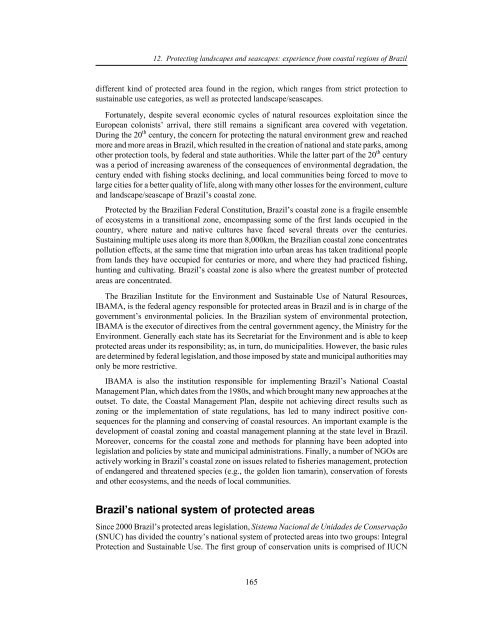The Protected Landscape Approach - Centre for Mediterranean ...
The Protected Landscape Approach - Centre for Mediterranean ...
The Protected Landscape Approach - Centre for Mediterranean ...
Create successful ePaper yourself
Turn your PDF publications into a flip-book with our unique Google optimized e-Paper software.
12. Protecting landscapes and seascapes: experience from coastal regions of Brazil<br />
different kind of protected area found in the region, which ranges from strict protection to<br />
sustainable use categories, as well as protected landscape/seascapes.<br />
Fortunately, despite several economic cycles of natural resources exploitation since the<br />
European colonists’ arrival, there still remains a significant area covered with vegetation.<br />
During the 20 th century, the concern <strong>for</strong> protecting the natural environment grew and reached<br />
more and more areas in Brazil, which resulted in the creation of national and state parks, among<br />
other protection tools, by federal and state authorities. While the latter part of the 20 th century<br />
was a period of increasing awareness of the consequences of environmental degradation, the<br />
century ended with fishing stocks declining, and local communities being <strong>for</strong>ced to move to<br />
large cities <strong>for</strong> a better quality of life, along with many other losses <strong>for</strong> the environment, culture<br />
and landscape/seascape of Brazil’s coastal zone.<br />
<strong>Protected</strong> by the Brazilian Federal Constitution, Brazil’s coastal zone is a fragile ensemble<br />
of ecosystems in a transitional zone, encompassing some of the first lands occupied in the<br />
country, where nature and native cultures have faced several threats over the centuries.<br />
Sustaining multiple uses along its more than 8,000km, the Brazilian coastal zone concentrates<br />
pollution effects, at the same time that migration into urban areas has taken traditional people<br />
from lands they have occupied <strong>for</strong> centuries or more, and where they had practiced fishing,<br />
hunting and cultivating. Brazil’s coastal zone is also where the greatest number of protected<br />
areas are concentrated.<br />
<strong>The</strong> Brazilian Institute <strong>for</strong> the Environment and Sustainable Use of Natural Resources,<br />
IBAMA, is the federal agency responsible <strong>for</strong> protected areas in Brazil and is in charge of the<br />
government’s environmental policies. In the Brazilian system of environmental protection,<br />
IBAMA is the executor of directives from the central government agency, the Ministry <strong>for</strong> the<br />
Environment. Generally each state has its Secretariat <strong>for</strong> the Environment and is able to keep<br />
protected areas under its responsibility; as, in turn, do municipalities. However, the basic rules<br />
are determined by federal legislation, and those imposed by state and municipal authorities may<br />
only be more restrictive.<br />
IBAMA is also the institution responsible <strong>for</strong> implementing Brazil’s National Coastal<br />
Management Plan, which dates from the 1980s, and which brought many new approaches at the<br />
outset. To date, the Coastal Management Plan, despite not achieving direct results such as<br />
zoning or the implementation of state regulations, has led to many indirect positive consequences<br />
<strong>for</strong> the planning and conserving of coastal resources. An important example is the<br />
development of coastal zoning and coastal management planning at the state level in Brazil.<br />
Moreover, concerns <strong>for</strong> the coastal zone and methods <strong>for</strong> planning have been adopted into<br />
legislation and policies by state and municipal administrations. Finally, a number of NGOs are<br />
actively working in Brazil’s coastal zone on issues related to fisheries management, protection<br />
of endangered and threatened species (e.g., the golden lion tamarin), conservation of <strong>for</strong>ests<br />
and other ecosystems, and the needs of local communities.<br />
Brazil’s national system of protected areas<br />
Since 2000 Brazil’s protected areas legislation, Sistema Nacional de Unidades de Conservação<br />
(SNUC) has divided the country’s national system of protected areas into two groups: Integral<br />
Protection and Sustainable Use. <strong>The</strong> first group of conservation units is comprised of IUCN<br />
165

















